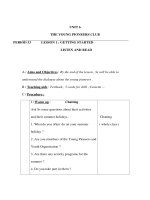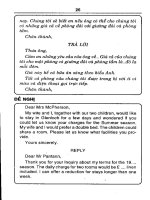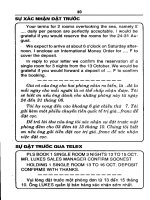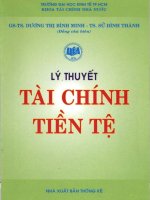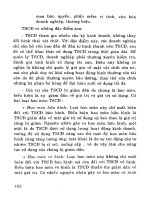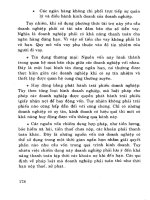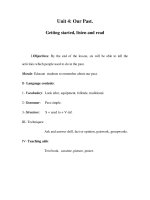Read and Understand Fiction Grades 4 - 6
Bạn đang xem bản rút gọn của tài liệu. Xem và tải ngay bản đầy đủ của tài liệu tại đây (6.33 MB, 149 trang )
$16.99USA
EMC 748
Grades 4–6
to State
Standards
Correlated
Read and Understand
,
F
i
ct
i
o
n
Grades 4–6
Read and Understand, Fiction
i
s a resource book containin
g
a variety of fictional storie
s
a
nd practice materials for a wide spectrum of readin
g
skills.
T
he 22 two-pa
g
e stories vary in readin
g
difficulty from the be
g
innin
g
of
g
rade 4 throu
gh
gra
d
e 6.
E
ach story is followed by four pa
g
es of activities for practicin
g
readin
g
skills such as:
•
com
p
re
h
ens
i
on
•
voca
b
u
l
ar
y
•
or
g
anizin
g
informatio
n
•
structura
l
ana
ly
s
is
•
p
arts of s
p
eec
h
S
p
ecific skills
p
racticed are listed in the table of contents.
S
tories and lan
g
ua
g
e activities can be used for small- and lar
g
e-
g
roup lessons
,
c
ooperat
i
ve
l
earn
i
n
g
pro
j
ects, an
d
at-
h
ome rea
di
n
g
pract
i
ce.
Author: TeklaWhite
Editor: MarilynEvans
CopyEditor: CathyHarber
Illustrators: DonRobison
JoLarsen
ShannonFrederickson
Desktop: ShannonFrederickson
Cover: CherylPuckett
EMC748
Visit
www.teaching-standards.com
toviewacorrelationof
thisbook’sactivities
toyourstate’sstandards.
Thisisafreeservice.
Correlated
to State Standards
Congratulations on your purchase of some of the
finest teaching materials in the world.
Photocopying the pages in this book is permitted for
single-classroom use only. Making photocopies for additional
classes or schools is prohibited.
For information about other Evan-Moor products, call 1-800-777-4362,
fax 1-800-777-4332, or visit our Web site, www.evan-moor.com.
Entire contents ©1999 EVAN-MOOR CORP. 18 Lower Ragsdale Drive,
Monterey, CA 93940-5746. Printed in USA.
Evan-Moor E-books
Si
ngle-
C
lassroom
U
ser
A
greemen
t
W
ith the purchase of electronic materials
(
such as e-books and
p
rint-on-demand teachin
g
activities
)
from an Evan-Moor website, or
that of an Evan-Moor authorized dealer’s website, you are
g
ranted a
s
i
n
gl
e-c
l
assroom user
li
cense w
hi
c
h
ent
i
t
l
es you to use or
d
up
li
cate
these materials for a sin
g
le classroom
(
or home
)
only. Additionally,
t
h
ese e
l
ectron
i
c mater
i
a
l
s ma
y
b
e transm
i
tte
d
to ot
h
ers w
i
t
hi
n t
h
e
c
ommunity of a sin
g
le classroom
(
or home
)
via a secure intranet,
website, electronic bulletin board, FTP site, or news
g
roup. Sharin
g
the
materials or makin
g
copies for additional classrooms or schools or for
other individuals is prohibited. Use of the materials for anythin
g
other
than classroom instruction is a violation of Evan-Moor Educational
Publishers’ intellectual property ri
g
hts. Evan-Moor Corporation retains
full intellectual property ri
g
hts on all its products, and these ri
g
hts
e
xtend to electronic editions of complete books and individual teachin
g
a
ctivities offered for sale in di
g
ital format.
I
f
y
ou would like to use Evan-Moor e-books for additional purposes not
outlined in the sin
g
le-classroom license
(
described above
)
, please visit
for an
A
pp
li
cat
i
on to
U
se
C
opyrighted Materials form.
www.evan-moor.com
©1999 by Evan-Moor Corp. 1 Read and Understand, Fiction • Grades 4–6 • EMC 748
Table of Contents
Introduction 2
Stormalong—An American Tall Tale 4
recall details, draw conclusions, summarizing, word
meaning, synonyms, exaggeration
Iggie—Contemporary Realistic Fiction 10
recall details, draw conclusions, inference, word
meaning, compound words, action verbs
The Boy Who Didn’t Know Fear—
An Adaptation of a European Folktale 16
recall details, inference, antonyms, word meaning,
story setting
The Day Pecos Bill Rode
Old Twister—An American Tall Tale 22
recall details, word meaning, similes, exaggeration
Belling the Cat—An Adapted Fable 28
recall details, inference, critical thinking, word
meaning, point of view, quotation marks
The Day the Yam Talked—
An Ashanti Folktale 34
recall details, draw conclusions, word meaning,
personification, story setting, point of view
The Warrior and the Princess—
The Mexican Legend of Ixtaccihuatl
and Popocatepetl 40
recall details, draw conclusions, word meaning,
adjectives, similes
The Fox and the Crow—An Adapted
Fable 46
recall details, inference, critical thinking, word
meaning, prefixes, write a fable
The Missing Grocery Money—
Contemporary Realistic Fiction 52
recall details, inference, critical thinking, word
meaning, characterization, sequence events,
summarizing, suffixes
The One-Inch Boy—
An Adaptation of a Japanese Folktale 58
recall details, inference, draw conclusions,
word meaning, sequence events
The Contest—An Invented Folktale 64
recall details, cause & effect, critical thinking,
word meaning, characterization, synonyms
Runner Up—
Contemporary Realistic Fiction 70
recall details, inference, word forms, multiple
meanings, nouns & verbs, creative writing
The Spring Swim—An Adapted Fable 76
recall details, draw conclusions, fact & opinion,
critical thinking, word meaning, creative writing,
alphabetical order
Kaleidoscope—A Poem 82
descriptive language, adjectives, rhyming,
classification
Journey North—Historical Fiction 88
recall details, inference, word meaning, verbs,
pronouns, sequence events, generalizing
The Race—
Contemporary Realistic Fiction 94
recall details, inference, word meaning,
action verbs, figurative language
Two Sisters—A Folktale 100
recall details, draw conclusions,
characterization, word meaning, homophones
Out of Space—Science Fiction 106
recall details, inference, draw conclusions,
word meaning, syllables
The Gift—
Contemporary Realistic Fiction 112
recall details, inference, compound words,
homophones, contractions, word meaning
The Tower—A Folktale 118
recall details, draw conclusions, word meaning,
problem/solution, point of view
The Missing Ring—
Contemporary Realistic Fiction 124
recall details, critical thinking, draw conclusions,
word meaning, suffixes/root words, sequence
events, writing about personal experiences
Play Ball!—
Contemporary Realistic Fiction 130
recall details, draw conclusions, word meaning,
compound words, inference, characterization
Answer Key 136
©1999 by Evan-Moor Corp. 2 Read and Understand, Fiction • Grades 4–6 • EMC 748
Introduction
The Stories
Types of Stories
• contemporary fiction
• fables
• science fiction
• tall tales
• historical fiction
• poetry
• folktales
Ways to Use the Stories
1. Directed lessons
• with small groups of students reading at the same level
• with an individual student
2. Partner reading
3. With cooperative learning groups
4. Independent practice
• at school
• at home
Things to Consider
1. Determine your purpose for selecting a story—instructional
device, partner reading, group work, or independent reading.
Each purpose calls for a different degree of story difficulty.
2. A single story may be used for more than one purpose. You
might first use the story as an instructional tool, have partners
read the story a second time for greater fluency, and then use
the story at a later time for independent reading.
3. When presenting a story to a group or an individual for the first
time, review any vocabulary that will be difficult to decode or
understand. Many students will benefit from a review of the
vocabulary page and the questions before they read the story.
©1999 by Evan-Moor Corp. 3 Read and Understand, Fiction • Grades 4–6 • EMC 748
Skills Pages
Types of Skill Pages
Four pages of activities covering a wide variety of reading skills
follow each story:
• comprehension
• vocabulary
• organizing information
• structural analysis
• parts of speech
• literature analysis and creative writing
Ways to Use the Skill Pages
1. Individualize skill practice for each student with tasks that
are appropriate for his or her needs.
2. As directed minilessons, the skill pages may be used in
several ways:
• Make a transparency for students to follow as you
work through the lesson.
• Write the activity on the board and call on students to
fill in the answers.
• Reproduce the page for everyone to use as you direct
the lesson.
3. When using the skill pages for independent practice, make
sure that the skills have been introduced to the reader.
Review the directions and check for understanding. Review
the completed lesson with the student to determine if further
practice is needed.
©1999 by Evan-Moor Corp. 4 Read and Understand, Fiction • Grades 4–6 • EMC 748
Stormalong
S
tormalong was a big baby. He outgrew
his cradle a week after he was born.
By the time Stormalong celebrated his first
birthday, he had to sleep and eat in the barn
with the horses because the house was too
small. Before Stormalong blew out the
candles on his second birthday cake,
he was taller than the church steeple.
When Stormalong was five years old,
his mother knitted a hammock that
stretched from New Bedford,
Massachusetts, to Newport, Rhode
Island. His father tied one end of the
hammock to a giant pine tree in
New Bedford and sailed down the
coast to Newport. Then he
fastened the other end to the
top of an enormous chestnut tree.
“There, now,” said his mother. “It will take you a few years to outgrow this bed.”
Stormalong loved the sea and the ships. From his hammock bed, stretched between
Massachusetts and Rhode Island, he could watch ships come and go. He knew when the fishing
ships sailed into port and what they brought home. “The
Barstow
is on her way in with a load of
halibut and cod,” he shouted when he saw the
Barstow
heading for land.
When the people in town heard Stormalong’s announcement, they rushed to the dock to
buy fresh fish and welcome the crew home.
Stormalong knew all the ship captains. He signed up as cabin boy on the biggest ship he
could find, the
Goliath
. All went well as long as he stayed in the middle of the ship. If he leaned
over the port side of the ship, the crew had to run to the starboard side so the ship wouldn’t roll
into the sea. Stormalong could scrub the decks, throw out the anchor, or turn the wheel faster
than the rest of the crew.
By the time Stormalong was eleven, he had outgrown the
Goliath
. He decided to build the
biggest ship that ever sailed the ocean. It would take many tons of lumber to construct a ship
that large. Stormalong didn’t want to cut down all the trees near New Bedford. He liked the birds
singing him to sleep each night when he slept in his hammock. He knew they needed trees
An American Tall Tale
©1999 by Evan-Moor Corp. 5 Read and Understand, Fiction • Grades 4–6 • EMC 748
in which to build their nests. He solved the problem by chopping down three trees from each
forest from the Atlantic Coast to Pennsylvania.
To earn money for food and tools, Stormalong carried basket loads of fish from ships
anchored in the bay to the towns along the shore. The water was never higher than his knees. He
talked to ship captains and learned all he could about the oceans and ships.
By the time Stormalong finished building his ship, he was thirteen. He’d taught himself
everything there was to know about reading, math, and the stars. He didn’t need a crew. He could
were hired to prepare meals for Stormalong and the cats. He christened his ship
Colossus
.
When the ship was loaded with food and the sails were in place, Stormalong swam across
the harbor and pulled the ship into deep ocean water. He climbed up the ship’s ladder and set
America. The
Colossus
didn’t quite make the turn when it tried to squeeze between South
America and Antarctica. It rammed into South America and broke the tip into small islands and
ships could sail between the islands and get from one side of South America to the other. It was
a good shortcut.
Stormalong sailed on to China, India, and many islands along the way. He traded for
exquisite silks and finely decorated china dishes. He took on bags of pepper and tea leaves. In
rich man. He tried to settle down on land, but he couldn’t stay. It was too crowded. Everywhere he
With his crew of cats and cooks, Stormalong sailed to the Caribbean Sea. Just as he was
passing Florida, a tremendous hurricane tore at the sails of the
Colossus
. Ships sailing nearby
were being tossed to and fro and swamped with water. Stormalong jumped overboard and swam
through the towering waves. He piled as many boats as he could on the deck of the
Colossus
.
He pulled sailors from the water and put them safely in the hold of his ship. The storm raged on.
Stormalong put the anchor chain between his teeth and swam toward Florida, pulling the
ship against the wind and torrential rains. He pushed the ship up onto the beach, where waves
dashed against it for two days and nights. When the storm finally wound down, the sailors climbed
down the ladder of the
Colossus
to thank Stormalong.
After everyone had left the ship, Stormalong went back on board. He unfurled the sails to
see if they could be repaired. A great wind, the last breath of the hurricane, hit the sails. The sails
flapped like the wings of a giant albatross, lifting the ship and Stormalong into the sky. Stormalong
a giant sailor and the largest ship that w
as ever built.
do everything a hundred seamen could do, and do it much faster at that. He signed on a crew of
five cooks and four cats. The latter were to keep the rats from boarding the ship, and the former
sail. The
Colossus
was as fast as it was large. In no time at all, it had reached the tip of South
pieces of land. After that, there was a passageway called a strait through South America. Smaller
waved good-bye and sailed off. If you look at the night sky, just as sailors often do, you might see
the light from Stormalong’s lantern flashing across the sky. That’s the
Colossus
and Stormalong
’
tw
o months time, he was back in New Bedford. He sold everything on the ship and became a very
went, he had to be careful he didn’t step on a house or garden.
sailing across the immense ocean of air that surrounds the Earth. It’s the only sea big enough for
Name
©1999 by Evan-Moor Corp. 6 Read and Understand, Fiction • Grades 4–6 • EMC 748
Questions about
Stormalong
1. Stormalong’s mother made him a special place to sleep. Describe it.
2. Why did Stormalong decide to build his own boat? What was unique about the boat?
3. What did Stormalong name his boat? Why do you think he chose that name?
4. What happened when the
Colossus
tried to go around the tip of South America?
5. Some people say Stormalong had a big heart. Why?
6. In your own words, tell about Stormalong’s Caribbean adventure. Use the back of the
paper if you need more space.
Name
©1999 by Evan-Moor Corp. 7 Read and Understand, Fiction • Grades 4–6 • EMC 748
Stormalong
Vocabulary
Match each word from the story with its definition. Use the clues in the story to help you
decide what each word means.
1.
, right and left sides of a ship
2.
a bed of woven cord, strung between two places
3.
a tower on a church
4.
a large edible fish; a flounder
5.
a narrow passageway of water
6.
the second one mentioned
7.
named a ship
8.
the first one mentioned
9.
Fill in the blanks in the sentences using the best answer from this list of words.
tremendous immense raged exquisite unfurled
1. Stormalong
the sails to see if they could be repaired.
2. The storm
for two days causing
damage and flooding.
3. There is an
4. The
jewels in the crown sparkled under the bright lights.
steeple hammock port starboard halibut
anchored latter former christened strait
held in place by a heavy metal object attached to a chain
ocean of air surrounding the Earth.
Name
©1999 by Evan-Moor Corp. 8 Read and Understand, Fiction • Grades 4–6 • EMC 748
Stormalong
Synonyms
A synonym is a word that means the same or almost the same as another word.
Write the number of each word on the line in front of its synonym.
List 1 List 2
1. christened
saw
2. rushed
first
3. immense
tied
4. watched
hired
5. fastened enormous
6. signed on
welcomed
7. latter
hurried
8. former
last
9. greeted
named
Choose a word from List 1 above to complete each sentence below.
1. Everyone in town
to the dock to buy fresh fish and
the crew.
2. He
his ship the
Colossus
.
3. The
ocean of air was the only place big enough for a
giant sailor.
4. He
ships come and go from his hammock bed.
5. He
five cooks and four cats.
6. He
the other end to the top of an enormous
chestnut tree.
7. The
were to keep the rats from boarding the ship, and
the
were hired to prepare meals for Stormalong.
Name
©1999 by Evan-Moor Corp. 9 Read and Understand, Fiction • Grades 4–6 • EMC 748
Stormalong
Exaggeration
Exaggeration is an important part of the type of stories called tall tales. The heroes
and heroines of the tales are gigantic and extravagant. The exaggerated feats of
courage and endurance gave early settlers encouragement to face the task of
developing a new land.
Find examples of exaggeration in
Stormalong
that support each of the statements
below. Write the examples on the lines following each statement.
Stormalong was a big baby.
Stormalong earned money to build his ship.
Stormalong didn’t need a crew.
Stormalong rescued ships and sailors from a Caribbean hurricane.
©1999 by Evan-Moor Corp. 10 Read and Understand, Fiction • Grades 4–6 • EMC 748
Iggie
I
ggie had vanished. That was all there was to it. He had ventured outside before
when the window in the kitchen was left open. Martin had always found him in the
garden, sitting in the sun while he munched on flowers. This time he didn’t seem to be
anywhere near Martin’s apartment.
A year ago someone had left an iguana in a box at the pet store where Aunt Belle
worked. She guessed that the iguana was too big for his owners to take care of, or they
didn’t want him anymore. The store didn’t have a cage big enough for a full-grown iguana,
so Aunt Belle brought him home. That was just a week before Martin’s birthday. Iggie was
the best present Martin had ever received.
Now Martin was worried. It was getting colder at night, and iguanas needed to
stay warm. He and his friend Arnold searched the garden, looking under all the bushes.
They knocked on apartment doors and talked to the people who were home. Mr. Kennon
had seen an iguana outside the laundry room early that morning.
Martin and Arnold searched the laundry room. They looked behind the machines,
under the tables, and even inside the washers and dryers.
“Maybe he got locked in someone’s apartment by mistake,” Arnold said. “We could
check it out. He likes to sit in the windows.”
Martin and Arnold walked around the apartments. The lady who lived in the
apartment above Martin’s jerked her blinds shut when she saw them looking in her window.
In the next apartment, Aunt Mary (everyone called her that even though she wasn’t
anyone’s aunt) just waved and said, “Come on in.”
Martin and Arnold asked Aunt Mary if she had seen Iggie.
“I’ve been in and out all day. I had to do some laundry for Sis since she’s been sick,” said
Aunt Mary. “I drove a big basket of clothes over to her apartment, but I didn’t see that iguana of
yours. If I had seen that green, scaly creature, I would have hollered real loud. You know I’m not
much for animals without fur. I hope you find him real soon, and I hope I don’t.”
Martin and Arnold searched under the cars and all around the parking lot. “Iggie would like
the warm pavement here, but this sure wouldn’t be a good place for an iguana,” said Martin. A car
zoomed into a parking space.
“Right!” said Arnold. “He’d be so scared that he’d lose his tail here for sure.” They didn’t find
any long tail lying around on the pavement.
©1999 by Evan-Moor Corp. 11 Read and Understand, Fiction • Grades 4–6 • EMC 748
“Let’s look through the garbage cans,” said Martin. “He might smell something he wants to
eat there. There are always bugs around too.”
They borrowed some gloves from Angela, the maintenance person. Holding their noses
with one hand and shaking the garbage cans around with the other, Martin and Arnold looked in
all the cans. There weren’t any long tails or spiny backs poking out of the garbage.
Martin set a bowl of mealworms and a piece of banana outside his apartment door. “He
won’t eat unless he’s warm,” worried Martin, “but I guess it won’t hurt to leave something out for
him.” As the sun went down, Arnold went home for dinner. Martin sat on a tall stool by the kitchen
window while he ate his potato soup. Every few minutes he looked around outside.
“You might as well give up for now,” Aunt Belle said. “Iggie probably found himself a warm
spot for the night.” Martin thought Aunt Belle looked worried. She kept looking out the windows too.
A warm spot! She was right, Martin thought. Iguanas always headed for the warmest place
around. But he’d looked everywhere warm he could think of—the parking lot, the dryers in the
laundry room. Then Martin remembered what Aunt Mary had said about taking the laundry to her
sister’s apartment. Hot laundry right out of the dryer was a perfect place for an iguana.
“Aunt Belle,” Martin called. “I’ve got to talk to Aunt Mary right away.”
“Her number’s by the phone,” Aunt Belle answered.
It didn’t take long to convince Aunt Mary that they ought to take a look at her sister’s basket
of laundry.
Aunt Mary talked to Aunt Belle on the telephone before she stopped by for Martin. Then
she drove Martin across town to Sis’s apartment. “Don’t get your hopes up, Martin. I’m sure
I would have noticed Iggie’s long tail poking out of the laundry basket if he crawled in there.”
Aunt Mary knocked on Sis’s door and called out, “It’s me again. I brought company.” Sis
unlocked the door.
Sis was sitting up in a chair watching TV. “Funny joke,” she said to Aunt Mary. She pointed
to a motionless Iggie stretched out on top of the TV. “Where did you get such a real-looking stuffed
toy? I think it’s real cute on top of the TV.”
Martin and Aunt Mary laughed. Iggie climbed down the front of the TV and made his way
toward Martin.
Aunt Mary’s sister shrieked, “It’s got batteries!”
Martin set Iggie on his shoulders. “It’s really Martin’s pet iguana, not a toy,” said Aunt Mary.
“He must have crawled into the laundry basket this morning and hidden under the warm clothes.”
“I can’t believe I let a live lizard sit on my bed,” Sis said. “I carried it around the house this
afternoon and showed it to my neighbor.”
“Next time you’re sick, I’ll bring Martin and Iggie for a visit,” said Aunt Mary. “You look a lot
better now.
Iguana sitting
seems to agree with you.”
Name
©1999 by Evan-Moor Corp. 12 Read and Understand, Fiction • Grades 4–6 • EMC 748
Questions about
Iggie
1. Aunt Belle gave two reasons why she thought people had left Iggie at
the pet store. What were they?
2. List the places Martin and Arnold looked for Iggie.
a.
b.
c.
d.
e.
3. What gave Martin the idea that Iggie might have hidden in Aunt Mary’s sister’s
basket of clothes?
4. How was it possible that Sis thought that Iggie was a stuffed toy?
5. What kind of a person do you think Aunt Mary is? Use clues in the story to explain
your answer.
Name
©1999 by Evan-Moor Corp. 13 Read and Understand, Fiction • Grades 4–6 • EMC 748
Iggie
Vocabulary
A. Fill in the blanks in the sentences using these words.
1. The
felt hot when Jeremy sat on the curb to watch
the parade.
2. The
changed into beetles.
3. The rabbit
on the cabbage.
4. Agnes
her room for her new tennis shoes.
5. He
two books for his birthday.
6. All reptiles are
.
7. The
workers made repairs to the machines.
8. Are all cactus
?
9. Many toys need
.
10. The
ate flowers and a piece of banana.
B. Some words in the story tell about placement or direction. An example is the word
up
. The monkey climbed
up
the tree.
Find 10 direction words in the story and write them on these lines.
maintenance pavement mealworms received iguana
spiny batteries munched searched scaly
Name
©1999 by Evan-Moor Corp. 14 Read and Understand, Fiction • Grades 4–6 • EMC 748
Iggie
Compound Words
Compound words are two words that are joined together to make another word.
For example, a
coatrack
is a rack for coats. A
backyard
is a yard in back of a house.
1. Three of the compound words in the story are
someone
,
without
, and
afternoon
.
Write a sentence about the story using each of those compound words.
2. Find three other compound words in the story. Write them on these lines.
3. Combine each word from the first column with a word from the second column to
make a compound word. Write your compound words on the lines.
blue dated
house foot
fire time
side car
street sticks
bare bird
bread walk
out boat
over wood
some due
Name
©1999 by Evan-Moor Corp. 15 Read and Understand, Fiction • Grades 4–6 • EMC 748
12
3
45
6
7
8
9
10
11
12
Iggie
Action Verbs Crossword Puzzle
The following verbs, or forms of the verbs, are found in the story. Use the clues and
write the words in the crossword puzzle.
Across
1. sees
3. to move on hands and knees
4. to suppose or estimate
6. to look for
9. to rap on a door
10. to motion good-bye or hello
with the hand
12. to yell loudly
Down
2. to scream
5. to try to get by something
without being seen or caught
7. to make someone believe something
8. to move quickly
11. to move on foot at a regular pace
wave holler convince knock sneak crawl
looks search guess zoom walk shriek
Word Box
©1999 by Evan-Moor Corp. 16 Read and Understand, Fiction • Grades 4–6 • EMC 748
I
n the kingdom of Near and Far, there lived a boy
who didn’t know fear.
One morning his mother said, “I want to pick
fresh blackberries for a pie, but I fear the great bear
that lives in the forest.”
“What is fear?” asked the boy.
“Fear is when you feel worried that something
terrible will happen to you,” answered the mother.
“I can’t imagine how that would be,” said the
boy. “I must find fear and see for myself. I’ll go to the
berry patch.” The boy took a pail for the berries and
an ax to cut wood for a fire. Off he went.
He came to a sleeping giant. The boy looked
into the giant’s pockets. “No fear here,” he said. Then
he peered into the giant’s ears. “Nothing terrible
there.” The boy walked into the giant’s nose. “Hello,”
he called, “I’m looking for fear.” His voice echoed in the giant’s nose.
“Aaah-choo!” the giant sneezed. The boy flew out of the giant’s nose and landed on top of
a tall pine tree.
“I’m allergic to people. They make me sneeze!” bellowed the giant.
“Your sneeze blew me up into the tree,” said the boy. “I’m looking for fear.”
“Fear, is it?” the giant roared. “I’ll show you fear.” The giant pulled the boy’s tree out of the
ground and sent it sailing through the air.
“I’m flying over the forest like a bird!” shouted the boy. “I can see farms and villages.
There’s no fear in the sky.”
When the tree came down, it splashed into the sea. It rolled over and over, but the boy
held on. When the tree stopped spinning, the boy said, “I didn’t find any fear in the air or under
the water.”
The boy chopped off two limbs of the tree with his ax. He paddled his tree toward shore.
It started to rain. Lightning streaked down from the sky. The winds blew his tree onto the land.
The boy found a cave and crawled inside. “Now I’m inside the earth. I’ll try to find fear under the
ground.” The boy felt around the cave. He found a warm, furry bed.
The Boy Who Didn’t Know Fear
An Adaptation of a European Folktale
©1999 by Evan-Moor Corp. 17 Read and Understand, Fiction • Grades 4–6 • EMC 748
When the boy stretched out on the bed, there was a tremendous roar. The bed rolled over.
“It must be the great bear,” said the boy. “Now I’ll find fear.” The boy shook the great bear’s
legs. “Wake up,” he said. The bear shuddered and went back to sleep. The boy shouted in the
bear’s ear and poked her with a tree limb. The bear bounded out of the cave. The boy followed her,
waving the tree limb. “Wait!” yelled the boy. The bear ran faster.
“Mother was wrong,” said the boy. “I felt no fear when I saw the bear.” The boy filled his pail
with blackberries and walked back to his village.
There was a crowd of people in the town square. “Can you help me find fear?” the boy
asked a farmer.
arguments. Today the old judge will throw a laurel wreath over the crowd. If it lands on my head,
I’ll be the new judge.”
The boy crossed the square. He heard cheers and felt the laurel wreath fall on his head.
The crowd carried him to a towering throne. There he would sit for the next one hundred years.
He would listen to people’s arguments and try to make everyone happy. For the first time, the boy
felt fear.
“I’m too busy,” said a farmer. “Every hundred years, a new judge is chosen to settle
Name
©1999 by Evan-Moor Corp. 18 Read and Understand, Fiction • Grades 4–6 • EMC 748
Questions about
The Boy Who Didn
’
t Know Fear
1. Why didn’t the mother want to pick blackberries?
2. Why was the boy looking for fear?
3. What dangers did the boy find that did not make him feel fear?
a.
b.
c.
d.
4. When the boy was judge, what would he have to do?
5. Why did the boy feel fear when he became the village judge?
Name
©1999 by Evan-Moor Corp. 19 Read and Understand, Fiction • Grades 4–6 • EMC 748
The Boy Who Didn
’
t Know Fear
Antonyms
Antonyms are words that have opposite meanings. Examples of antonyms are
tall
–
short
and
quiet
–
loud
.
A. Find the antonyms for the following words in the story. Write the antonyms on
the lines.
1. emptied
2. right
3. cold
4. night
5. stale
B. There are many pairs of antonyms in this story. One example is the name of the
the stor
y and circle it. Then find the antonym for each word in the story. Circle the
antonym and write it on the line.
1. went
2. here
3. sky
4. under
5. ran
6. started
7. new
8. in
place where the boy lived, the kingdom of
Near
and
Far
. Find each word below in
Name
©1999 by Evan-Moor Corp. 20 Read and Understand, Fiction • Grades 4–6 • EMC 748
The Boy Who Didn
’
t Know Fear
Vocabulary
1. Fear is an emotion, or feeling, that you have when you are in danger. Envy,
happiness, and anger are other emotions. Which of these three emotions would
you feel if each of these things happened to you?
a.
Your brother or sister ate your piece of chocolate cake.
b.
Your friends have new bicycles.
c.
You finished your homework early so you can
watch your favorite TV program.
2. Write about a time when you felt each of these emotions.
a. fear:
b. envy:
c. happiness:
d. anger:
3. Use the clues in the story to match these words with their definition.
a.
dark green leaves tied in a circle
b.
huge, enormous
c.
very tall
d.
what you are when something makes you sneeze
or itch
e.
looked into something
towering laurel wreath peered tremendous allergic
Name
©1999 by Evan-Moor Corp. 21 Read and Understand, Fiction • Grades 4–6 • EMC 748
The Boy Who Didn
’
t Know Fear
Setting
The setting of a story is where and when it takes place.
Answer these questions about the setting of
The Boy Who Didn’t Know Fear
.
1. Where does the story take place?
2. List several different locations in the kingdom.
3. At what time of year do you think this story might have taken place?
4. What clue or clues helped you to choose the time of the story?
©1999 by Evan-Moor Corp. 22 Read and Understand, Fiction • Grades 4–6 • EMC 748
Y
ou’ve probably heard about Pecos Bill,
the Texas wrangler who was as tall as a
two-story house and as strong as an ox. When
it was time to round up the cattle and drive them
to Abilene, Bill just pointed his nose toward the
sky and let out a coyote howl that echoed across
Texas. The cattle thought there were a hundred
or so coyotes coming after them. They were so
spooked, they stampeded in the other direction
as fast as they could. Pecos Bill had cowpunchers
stationed all along the trail. They kept the cattle
running in the right direction. When the cattle slowed
down, Bill just let loose with another howl. The cattle
kept running until they all reached Abilene in record
time.
You might think it was strange that Bill
could howl like that. Bill, you see, came by it
naturally because coyotes raised him. Some folks
say he thought he was a coyote until he was fourteen
years old. Seems he got lost from his folks when they
were moving west. But that’s a story for another day.
Bein’ pretty much like a coyote, Bill would stop to sniff about every now and then. He could
smell almost anything in the air a hundred miles away. One morning he said, “Better head for the
cellars. There’s a twister coming!” Bill put his ear to the ground. “It just passed by El Paso and it’s
an hour away.”
That was enough time to get some of the cattle into the tunnel Bill had dug out using
Rattler, his pet snake, as a drill. As soon as everything was in order, the cowhands headed for
the cellars.
“You coming in?” yelled Cowpoke Carl.
“I’m gonna ride this one out!” shouted Bill.
Carl shut the wood cover to the cellar and bolted it in place.
As for the rest of the story, this here’s how Bill told it when he showed up a week or two
later. There isn’t any doubt it was the truth. Bill was as truthful as a Sunday school teacher.
It seems Bill and his horse, Bulldozer, waited until Old Twister came roaring across the
ranch like an angry panther chasing its dinner. When it caught sight of Bill, it took out after him.
An American Tall Tale
The Day Pecos Bill Rode Old Twister

